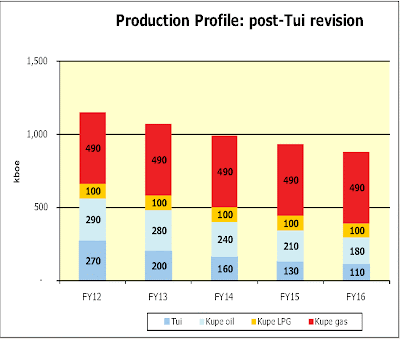One of the least understood elements of peak oil is the rapid decline rate of production from the peak for any given oil field. For an example of just how severe and steep the decline rate can be, look no further than the recent announcement that the Tui oil field in the Taranaki Basin has had its remaining oil reserves slashed by 1/5, and that production will fall off a cliff. For a New Zealand oilfield, this is peak oil in action with bells on.
We are all used to seeing breathless media announcements of "huge" new discoveries of oil. What we hardly ever hear about is when oilfields inevitably start to rapidly decline. No surprises therefore when the Tui reserve downgrade from 50.5 million to 40 million barrels was buried deep in the business section of our press and never made the front pages.
The remarkable story about the Tui oil field completely missed, or ignored by the business media, is just how quickly the field reach peak production, and how rapidly it’s decline will be.
It was only four years ago on 30 July, 2007 that Tui began production. 31 million barrels of oil have been produced in those four years. But the remaining 9 million barrels of expected reserves are projected to dribble out over the next 9 years before the field is fully depleted in 2020.
The steepness of the decline can be seen from this graph from a July 2011 New Zealand Oil and Gas report -- (representing its 12.5% stake in the Tui field). If you focus on the dark blue part of the graph at the bottom of each column you can see that NZOG’s share of production will fall from 270 kboe in 2012 to 200 kboe in 2013 -- representing a decline of 26% in oil flows for Tui in just one year.
The overall decline rate for the Tui oilfield in the four years between 2012 and 2016 is a staggering 59%!
Contrast this with the super optimistic projections for Tui when it was first discovered. As Greg Peel of International Business Times points out --
"Tui's reserves have been constantly upgraded over its life, suggesting a well life beyond 2030".
The steep decline rate at Tui should not be a surprise. As I pointed out in April, the IEA noted in its 2010 New Zealand Review
"recently commissioned producing fields, like Tui for example, are relatively small and have a high rate of depletion"Note : The same graph also shows a steep decline of 38% in 4 years for the Kupe oil field (light blue) which is also very high by international standards.
Why is this important?
It confirms that in the next four -- five years domestic oil production in New Zealand will fall off a cliff, at the very time a global oil supply crisis is unfolding. We are already hugely dependent on oil imports and vulnerable to any disruptions to supply. We will become even more dangerously dependent on a dwindling supply of oil from volatile world markets.
Meanwhile the government's "response" to peak oil is misguided and pathetic. We have no plan to lower our dependence on imported oil, other than “drill and hope”. No -- it's time to do a Thelma and Louise -- let’s all accelerate down the white elephant billion-dollar "roads of significance to National" and race over the oil crisis cliff!







0 comments:
Post a Comment